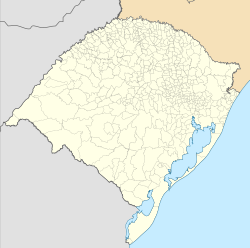Santa Maria Airport Aeroporto de Santa Maria | |||||||||||||||
|---|---|---|---|---|---|---|---|---|---|---|---|---|---|---|---|
 The check-in area at Santa Maria Airport | |||||||||||||||
| Summary | |||||||||||||||
| Airport type | Public/Military | ||||||||||||||
| Operator |
| ||||||||||||||
| Serves | Santa Maria | ||||||||||||||
| Time zone | BRT (UTC−03:00) | ||||||||||||||
| Elevation AMSL | 88 m / 289 ft | ||||||||||||||
| Coordinates | 29°42′39″S053°41′32″W / 29.71083°S 53.69222°W | ||||||||||||||
| Map | |||||||||||||||
 | |||||||||||||||
| Runways | |||||||||||||||
| |||||||||||||||
Santa Maria Airport( IATA : RIA, ICAO : SBSM) is the airport serving Santa Maria, Brazil.
Contents
It is operated by the Municipality of Santa Maria.
Some of its facilities are shared with the Santa Maria Air Force Base of the Brazilian Air Force.

